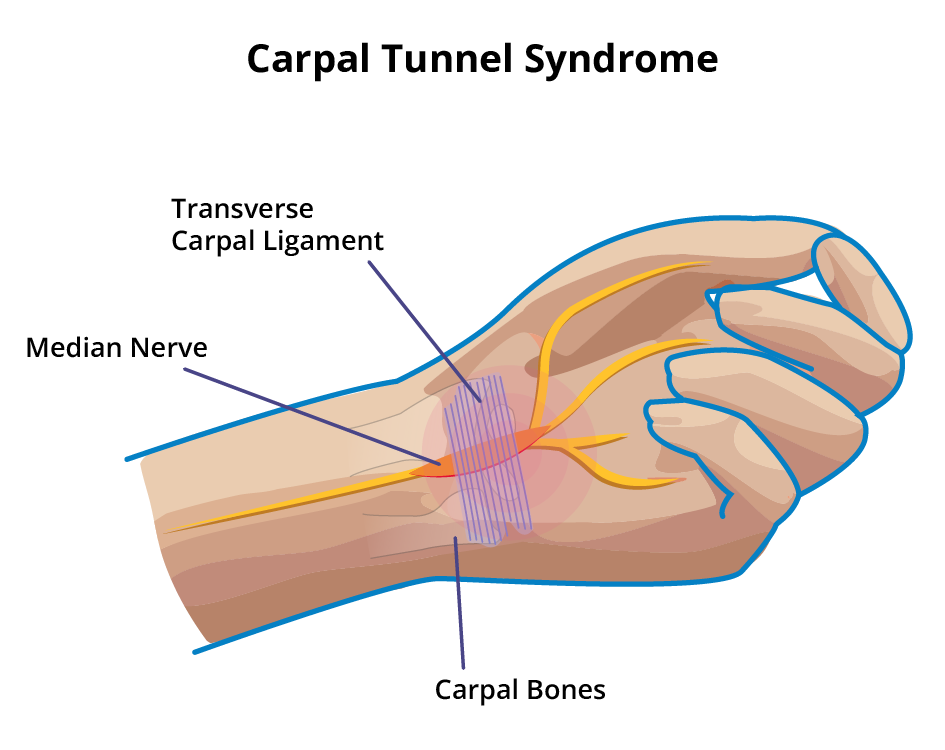Carpal Tunnel Syndrome
What is it?
Carpal tunnel syndrome is a common condition in the hand caused by compression on the median nerve, specifically the area where the nerve passes from the wrist into the hand. In most cases, the disease worsens over time, therefore early diagnosis and treatment is critical to prevent the likelihood of permanent damage.

Carpal Tunnel Syndrome
What are the symptoms?
The pressure on the median nerve causes numbness, tingling, and pain in the thumb, index, middle, and ½ of the ring finger. Over time and as the disease becomes more severe, you may experience weakness in grip strength and a decrease in muscle strength at the base of the thumb.
What is the cause?
Carpal tunnel syndrome is more common in women and can be caused by several factors.
Causes to carpal tunnel include:
- Frequent and repetitive hand movements (such as the use of a computer keyboard, playing certain sports, etc.) which may induce swelling to the tendons in the wrist over time which will put pressure on the nerve.
- Pre-existing joint/bone disease(s).
- Hormonal/metabolic changes.
- Genetic history.
How is it treated?
Carpal tunnel syndrome can be treated conservatively or with surgery.
- Conservatively: if the compression is not bad, splinting and physiotherapy can prevent progression.
- Surgery: if the compression on your nerve is severe, a surgical release by debriding the transverse carpal ligament is required to prevent progression and irreversible damage on your thenar muscle. This allows for more room for the nerve to function properly.

How is carpal tunnel diagosed?
Before surgery preparations
- A wrist brace should be purchased prior to your surgery as it must be worn immediately after the procedure. This brace should be brought with you to the surgery.
- Surgery is typically performed in outpatient surgery which means an overnight stay is not required.
- Fasting is not required for this surgery.
- Please let your surgeon know if you are taking blood thinners. Some patients who are on blood thinners may need to pause their medications.
During surgery
- First, your incision site is numbed using local anesthesia. After your hand is numbed, you will not feel any pain. However, during surgery you may feel some pushing and pulling while your surgeons are working on your hand, just like you do at the dentist.
- Right before the surgery begins, a tight cuff will be placed on your upper arm to constrict blood flow. The cuff will be inflated for approximately 5 to 10 minutes and may cause some discomfort.
- A small incision will be made at the base of your palm to allow the surgeon to debride the transverse carpal ligament.
- Once complete, the incision will be sutured, wrapped with dressings, and you will wear the wrist brace that you purchased.
After surgery management
What to expect
- You should not experience much pain after the procedure. If you experience pain, you may take over-the-counter Tylenol Extra Strength (Acetaminophen) or Advil (Ibuprofen) for pain relief. If you are experiencing severe pain, please contact your physician or go to the emergency room.
- Please note that swelling in the fingers is normal after your surgery.
- You may continue to feel numbness and tingling sensations after your procedure. This will continue to improve over a 6-month to 1-year period after your surgery.
- You will feel a slight decrease in grip strength after your procedure. This will continue to improve over the next 6 weeks after your surgery if you use your hand and do physiotherapy.
How to manage your wound
- For at least 2 days after the surgery, keep the dressing clean, dry, and intact.
- After 48 hours, you may remove the dressing and tensors (elastic bandage).
- You should wash the wound(s) with soap and water at least 3 times a day, and expose the wound to air to allow it to dry. Apply a thin layer of Polysporin to the incision site.
- You should have a follow-up appointment booked for 10 to 14 days after the procedure for your doctor to assess the wound and remove the sutures.
- Please note that a bit of swelling over the incision is normal. However, watch out for signs of infection such as redness that spreads beyond your incision(s), skin breaking open, and/or pus draining from the incision(s).
- If you experience any of these signs of infection, please call your surgeon to book an appointment as soon as possible or go to the emergency room.
Exercises for recovery
- You may start using your hands within 2 days after surgery.
- However, avoid heavy lifting or strenuous activity until the sutures are removed at your follow-up appointment.
- You should wear your wrist brace at all times. However, you should also remove the brace once every hour to perform gentle exercises and massages.
- Feeling hardness over the incision site after surgery is normal as it is a result of scar tissue development. After your stitches are removed, you should massage the area 3-4 times a day to help heal the skin and help with the sensitivity that develops with non-use. Over time, the hardness should go away.
Please click on the link below to watch a video demonstration from Dr. Hong’s YouTube channel on exercises you should do after your surgery.